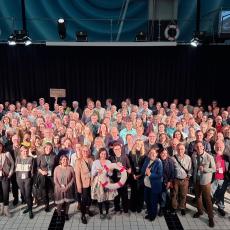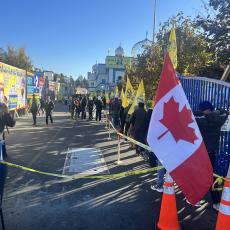I Advised The State As It Built 'Engaged California.' The Result Was a Pleasant Surprise.
This column is co-published with Zócalo Public Square.
In this dark moment of American dictatorship, California has turned on a small democratic light.
It’s called Engaged California, and it’s an online, nonpartisan tool for Californians to deliberate with one another and engage with their government.
At first glance, it might not seem like much. When you sign up with your email, pledge to behave with civility, and answer questions about your ideas and thoughts on issues related to the Los Angeles fires (the first use case for this tool), it might feel like just another online survey, with more open-ended questions.
But it is a big deal. Because the U.S., and California, have done little to encourage deliberative democracy, especially online. Which means that Engaged California could launch a new era in which technology gives people a chance to talk with each other, and to help determine more of the policies of their governments.
Before I go on, I should disclose that, since last year, I’ve been an unpaid advisor to the Engaged California project.
My role was to sit in on many, many Zoom calls, ask and answer questions, make suggestions, and help connect my fellow advisors and the state workers designing the tool to people around the world with deep expertise in digital and deliberative democracy.
I confess that, even while advising the project, I didn’t think it would ever be finished and used by the public. My pessimism started from the very moment last spring that a top state official first told me about his proposal for an online democratic platform. I was still pessimistic that summer when a friend at the Carnegie Endowment’s California program asked me to advise the state’s Office of Data and Innovation in an effort to create the platform. And I didn’t feel any more hopeful when leaders at the Berggruen Institute, where I’m a fellow in the Renovating Democracy program, urged me to accept that advising offer.
My profound pessimism was based on two decades of personal failure. Since 2006, I’ve written dozens of columns and convened events to convince Californians to adopt some of the best democratic practices and innovations from around the world.
I’ve watched sub-national governments, from Tokyo to Munich, hold hundreds of citizens assemblies, a form of deliberative democracy in which representative groups of everyday people, chosen by lot, make decisions. I’ve visited Madrid and Barcelona and talked to the people who created open-source digital tools for democratic governance that hundreds of cities around the world now use.
Many of the tools I’ve encountered seemed like they’d be especially popular here in California—a global leader in digital economy and a U.S. pioneer in direct democracy—but local and state governments alike ignored my suggestions. ()Petaluma is the only city here to have a citizens’ assembly, for example. So, I gave up hope, concluding that Californians and their government were arrogantly oblivious laggards in digital democracy and deliberation.
Last month, California proved me wrong—by debuting the first phase of Engaged California.
How did it happen? My fellow advisors, who include people with deep understanding of democracy and deliberation (led by the world’s first cabinet minister of digital democracy, Audrey Tang of Taiwan), were brilliant. They also were determined—the state of the world, and its democracy, created a sense of urgency.
But the real revelation while watching this process was the skill and creativity of the staff of the Office of Data and Innovation. These state workers did their homework and then some. Their ability to learn—they absorbed as much about digital and deliberative democracy in six months as I managed in my first decade of reporting—was awe-inspiring.
And they were patient as government higher-ups moved around deadlines, and late in the game, changed the subject of the first deliberation. Originally, the plan called for engaging Californians around social media rules for young people. But after the January fires in Los Angeles—with just weeks before the tool was to debut—the state switched the topic to address the disaster.
The launch of Engaged California in March was a historic event. California is the first state to make such a digital, deliberative tool available. It’s also the largest jurisdiction in the world to do so. (Other digital deliberative democracy tools have been enacted in cities, or smaller provinces or countries.) Engaged California is still a small pilot, but more than 7,000 people have signed up for it, as of this writing.
I’m even more hopeful for what might come next. Planning and work for the tool’s future is still in its early stages. But there is already talk and work being done for future phases of Engaged California.
This could mean more open-ended surveys like the one on the fires. Or it could mean more. For example, the answers that Californians are giving to Engaged California’s open-ended questions about the fires might be used to shape a more specific question to guide deliberations of small groups of Californians.
From what I’ve seen so far of the answers from the hundreds of Californians who have used the tool, my guess is that participants in such deliberations might tackle how to better support people affected by fires, how to reckon with insurance headaches post-disaster, or how to better prepare for future fires.
Out of those small group meetings might come a third phase—a truly deliberative citizens assembly, designed in response to what is determined by the small groups of the second phase. Conceivably, such an assembly could produce recommendations to governments and other institutions that could be implemented, perhaps by regulation, law, or even ballot measure.
There’s no guarantee that these future phases will happen, much less succeed. And this project has challenges, including a thorny one. Engaged California wouldn’t be happening now without the support of Gov. Gavin Newsom—who wrote a book more than a decade ago, called Citizenville, that discussed this model of decision-making. But Engaged California won’t survive and succeed as a project of one particular politician.
It can only succeed if Californians embrace it as their own. For you and me, that means more than just using it. It means participating in it, giving feedback, and urging that it change and develop in response to such input. Around the world, I’ve seen that the democratic tools that last—like the Madrid-originated CONSUL or Barcelona’s Decidim—are monitored and managed by everyday citizens.
That’s why we should all think of ourselves as advisors to Engaged California. Because this little democratic light of ours will keep shining only if we get over today’s dark pessimism and embrace such democratic tools as our own.




